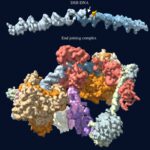Link to Pubmed [PMID] – 16786593
Link to HAL – Click here
Link to DOI – 10.1002/prot.21063
Proteins 2006 Sep;64(4):931-9
We propose a strategy based on the combination of experimental NH(N)/C(alpha)H(alpha) dipole/dipole cross-correlated relaxation rates and chemical shift analysis for the determination of Psi torsion angles in proteins. The method allows the determination of a dihedral angle that is not easily accessible by nuclear magnetic resonance (NMR). The measurement of dihedral angle restraints can be used for structure calculation, which is known to improve the quality of NMR structures. The method is of particular interest in the case of large proteins, for which spectral assignment of the nuclear Overhauser effect spectra, and therefore straightforward structural determination, is out of reach. One advantage of the method is that it is reasonably simple to implement, and could be used in association with other methods aiming at obtaining structural information on complex systems, such as residual dipolar coupling measurements. An illustrative example is analyzed in the case of the 30-kDa protein 6-phosphogluconolactonase.



